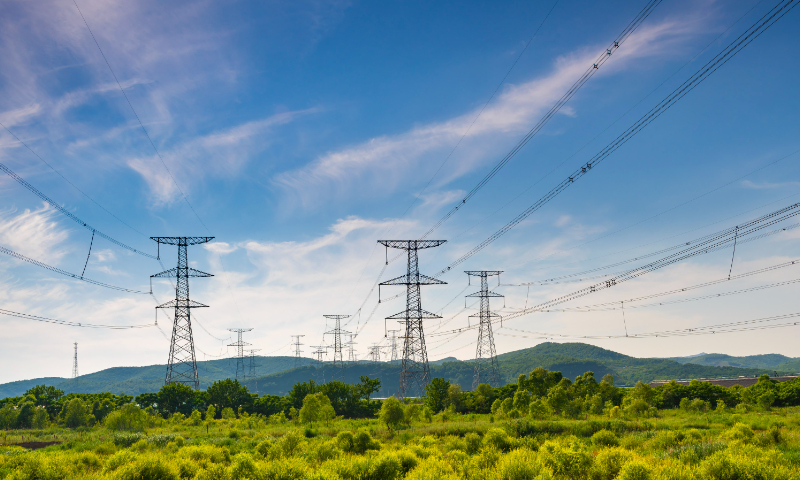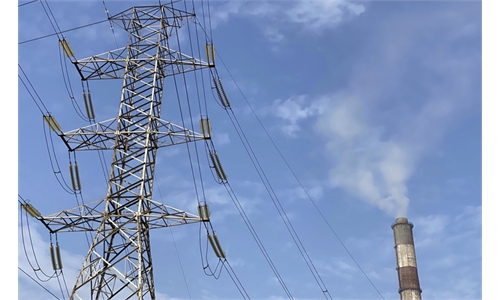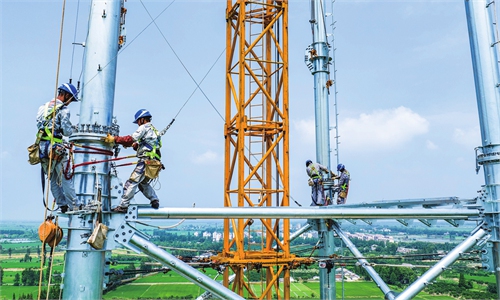
Power transmission lines are seen at Shaoguo village, Northeast China's Liaoning Province, on June 17, 2023. Photo: VCG
Since mid-June, many places in China have experienced high-temperature weather, with some areas having broken the records of the highest temperatures in the same period in history. As the surface temperatures in some areas exceeded 70 C recently, cooling demands drove up power consumption in China.
Apart from household power consumption, industrial demand also rose as China's economy continued to recover, and the strained power supply has become a problem to be urgently solved.
The maximum power load in the operating area of the State Grid, China's major power utility supplier, reached 890 million kilowatts recently. And the current maximum load of the power grid in the southern part of China reached 222 million kilowatts, which is close to the highest wattage in history, according to the China Electricity Council (CEC).
The CEC estimated that under normal weather conditions, China's maximum power load in 2023 will be about 1.37 billion kilowatts, 80 million kilowatts more than electric consumption in 2022. If there is a long period of large-scale extreme weather, the country's maximum power load may increase by about 100 million kilowatts compared with 2022.
There should be more electricity demand in 2023 than in 2022. So far, all sectors of the economy are recovering, especially production enterprises that are huge power consumers, Sheng Honglei, associate manager of CyberInsight New Energy Technology Co, told the Global Times.
From January to May, the electricity consumption of the secondary sector - processing, manufacturing, and construction companies - totaled 2,364.3 billion kilowatt-hours, accounting for 66.9 percent of total electricity consumption, according to data released by the CEC on Wednesday.
In terms of power supply, there are uncertainties in precipitation, landscape resources, and fuel supply. Macroeconomic growth, foreign trade exports, and extreme weather have also created uncertainties in consumer demand, said the CEC.
But industry practitioners said that at present, power supply in the heat-struck regions is generally smooth and stable. The National Energy Administration (NEA) also said on Wednesday that China's power supply will be characterized by a tight balancing act.
An employee at a power supply company in Zhangjiakou, North China's Hebei Province, told the Global Times on Monday that the amount of power generated in recent days is as scheduled, with stable output.
"Some villages had power outages that lasted up to one day due to the sudden increase in electricity use. We have dispatched employees to be on standby 24 hours a day to carry out repairs promptly. In general, our power supply is stable and sufficient," the employee said on condition of anonymity. Industry practitioners also noted that enterprises are encouraged to use electricity at varying peaks, so as to ensure power supply for residents, which is always a priority in China.
Well prepared
In order to meet power consumption demand, local governments, various government agencies, and enterprises have made preparations to guarantee power supply.
The NEA, for example, held a cross-provincial large-scale power outage emergency drill for the first time in East China in mid-June, in a bid to improve cross-provincial emergency response and ensure excellent service delivery in the response to power emergencies, according to an NEA announcement. This is also the largest and most targeted joint emergency drill conducted by public power emergencies so far.
"Major electricity companies are securing supply using coal-fired power. Meanwhile, China has approved many wind- and solar-powered projects to increase power supply," said Sheng.
Sheng also said that places like Southwest China's Sichuan Province, which used to rely on hydropower, have already stepped up the construction of other new-energy projects, such as photovoltaic power plants.
As one of the latest examples, the Kela PV power station, located in Sichuan and is the world's largest and highest-altitude hydropower and PV complementary power station, started power generation on Sunday.
With an installed capacity of 1 million kilowatts and an annual generating capacity of 2 billion kilowatt-hours, the Kela power station can meet the annual electricity demand of 700,000 households.
Sichuan bore the brunt of a drought in 2022 with temporary power shortages as the province relies on hydropower for approximately 80 percent of its power generation.
Another mega power project, the Baihetan-Zhejiang 800 kilovolt ultra-high voltage direct current transmission line project, went into full operation on Friday, and is able to transmit clean electricity generated at the Baihetan hydropower station in Sichuan and Yunnan in 7 milliseconds to East China's Zhejiang Province, which is about 2,000 kilometers away.
The line is an important part of the country's west-to-east power transmission program.
Security in green
By the end of May, China's installed power generation capacity was 2.67 billion kilowatts, up 10.3 percent year-on-year. The installed capacity of non-fossil energy power generation was 1.36 billion kilowatts, an increase of 17.7 percent year-on-year, accounting for 51.0 percent of the total installed capacity, according to statistics from the CEC.
At present, China's energy supply is being iteratively upgraded and transformed, Qi Haishen, executive vice president at the Yingkou Jinchen Machinery Co Ltd, told the Global Times on Monday. The company is a leading supplier of PV module equipment.
"Hydropower, wind power, and solar power generation, including the storage of new-energy power, is indeed playing a larger role in China's power supply. But the deployment of new-energy power generators cannot be completed overnight. Coal-fired power generation is still a major way of power supply in China," said Qi.
From January to May, power plants above the designated size, with an annual operational revenue surpassing 20 million yuan ($2.8 million), generated 3.42 trillion kilowatt-hours, up 3.9 percent year-on-year, according to data released by the CEC on Wednesday. During the same period, coal-fired power plants above the designated size generated 2.42 trillion kilowatt-hours of electricity, up 6.2 percent year-on-year.
This means that coal-fired power accounted for 70.7 percent of China's total power generation from January to May.
"Energy security is an important prerequisite. On the basis of ensuring energy supply, China is vigorously developing clean power, which is an important national policy during this energy transition period," Qi said.
There is no contradiction between an energy supply guarantee and the national green development and achieving the "dual-carbon targets," Chen Jia, an independent analyst focusing on global strategy, told the Global Times on Monday.
"At present, China has made great historical progress in the development of a green economy, the promotion of carbon neutrality, the acceleration of a virtual power plant technology breakthrough, and the construction of a distributed peak load management system," said Chen. "China's layout in hydropower, wind power, photovoltaic, and other next-generation green energy has taken shape."
Analysts noted that with the deployment of clean power projects, China will not return to the "coal-fire power era."



